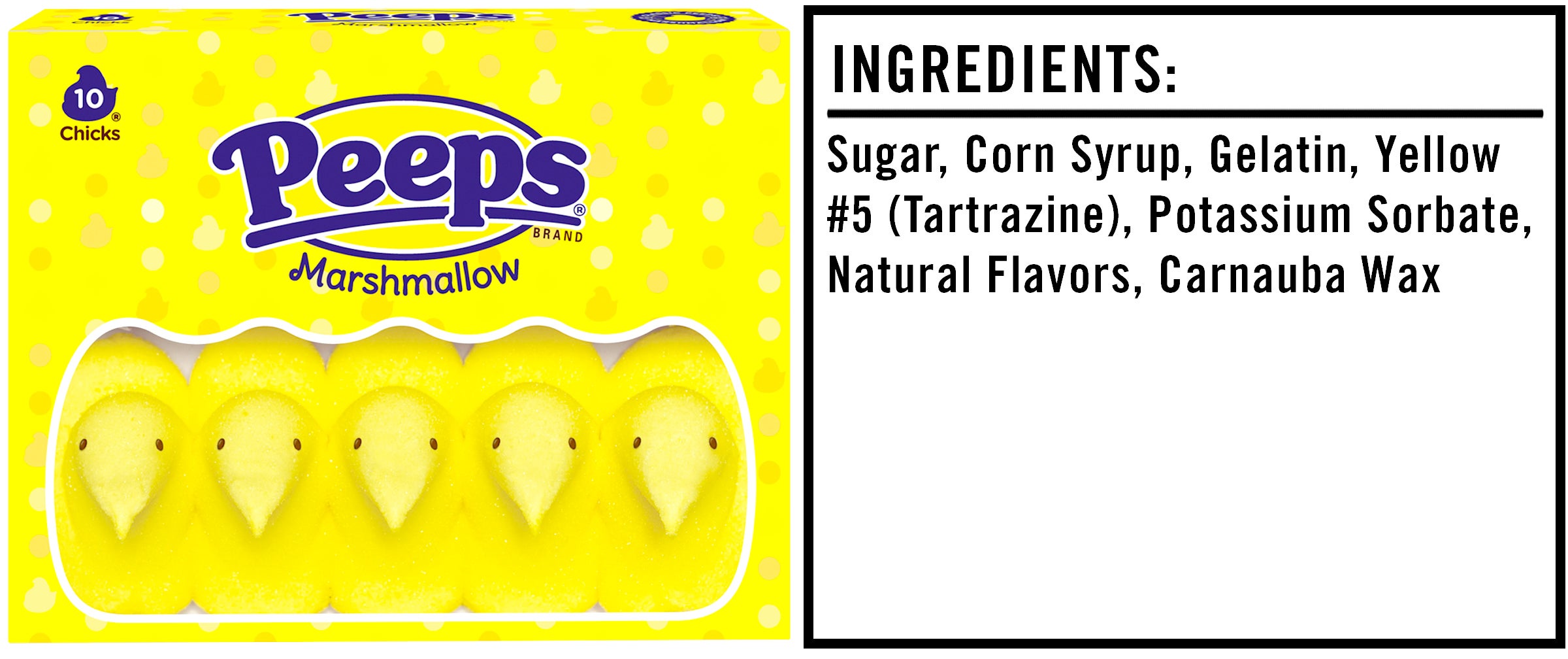We’re often told that you should never eat anything (or put anything on your body) if you don’t recognize everything on the ingredients list. But since most of us have no idea what xanthan gum or potassium benzoate are — or more importantly, what they’re doing to our bodies — we’re decoding the ingredients in the many things Americans put in (and on, or near) themselves.
This edition: Peeps Marshmallow Chicks, which are made from seven separate ingredients that we’ve broken down in the exact order they appear on their website.

The Ingredients
1) Sugar: As expected, Peeps are made up almost entirely of sugar. The recommended serving size, exactly five Peeps, delivers 30 grams of sugar, which is about as much as you should be consuming in a single day. The American Heart Association specifically recommends that men consume no more than 36 grams and women consume no more than 25 grams of added sugar per day, not including sugar found naturally in foods like fruits and vegetables.
2) Corn Syrup: Corn syrup is a liquid sweetener made of glucose. Translation: More sugar.
3) Gelatin: Vegans and vegetarians, beware: Gelatin is derived from all kinds of animal tissues — meat, bones, cartilage, whatever — and is a form of collagen, a protein found in connective tissues throughout the body. In Peeps, gelatin is what allows for the other ingredients (again, mostly sugar) to be molded into their recognizable, but lol-worthy shape.
4) Yellow #5 (Tartrazine): Artificial colors, including this one, have a bad reputation, but as physician and biochemist Cate Shanahan, author of Deep Nutrition: Why Your Genes Need Traditional Food, explained during my analysis of Doritos, studies arguing this are a bit flawed: “I’ve always been of the opinion that studies claiming artificial colors can cause cancer are irrelevant because [in the studies] they use really high amounts of the artificial colors — like, a million times more than you’d ever get [in your] food [throughout your lifetime].”
All in all, the average person’s liver should be able to break down whatever minuscule amount of artificial coloring we consume with food.
5) Potassium Sorbate: Potassium sorbate is a widely used preservative and generally an ingredient to steer clear of: According to a 2010 study published in Toxicology in Vitro, potassium sorbate damages DNA when exposed to human blood cells; however, long-term studies on the effects of regularly consuming the ingredient are required to provide a definitive answer on the matter. Plus, the amount in a few Peeps, eaten only on Easter, is probably inconsequential.
6) Natural Flavors: Natural flavors are literally flavors derived from an actual food source — i.e., lemon flavoring taken from real lemons.
7) Carnauba Wax: “Carnauba wax is a water insoluble substance used as a glazing, bulking and anticaking agent,” Dagan Xavier, ingredient expert and co-founder of Label Insight, told me during my analysis of the ingredients in Orbit White Spearmint Gum. It basically prevents Peeps from going all lumpy, and this particular wax is sourced from the copernicia prunifera, a plant grown only in northeastern Brazil.
The Takeaway
Nostalgia and tradition aside, Peeps are sugar-flavored animal sludge, blended with plant gunk and shaped into what a chick might look like a couple hours after you drop some wickedly potent acid. As a treat, they leave much to be desired, in my humble opinion.
However, people love their Peeps: Crocs disguised as Peeps are a thing for some strange reason, and placing Peeps on pizza has been a truly sick and disgusting Easter tradition for a while now.
Hey @discordapp, how many RT's to get @MalloryLoar to eat one of her Peepza Monstrosities? pic.twitter.com/1anWouf48Y
— Tabin Ahmad (@panicsw1tched) April 16, 2019
Love ’em or hate ’em, having a few on Easter should be fine. But if you eat Peeps with any regularity, reconsider your diet — and maybe your sense of taste, too.

